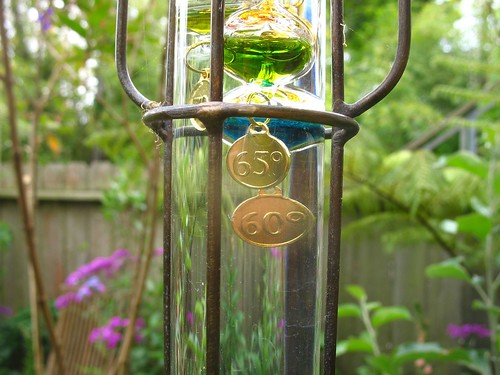
Feels more like 50. Coastal northern California comes with a built-in cooling system that guarantees cold, foggy weather after a string of warm days like we've had. Tomorrow it's supposed to warm up again.
It's time for some spring clean-up work in the garden. I've been very satisfied with everything so far this year. The wildflower show has been spectacular, with a lot still to come. Young shrubs and trees are growing and showing signs of their future selves. After months of anticipation, the Echium wildpretii has been pure delight.
The daffodils and snowflakes were especially fun this year. I only grow them in pots so I can move them out of the garden when the foliage starts to decline. Contrary to what you might think, I don't want to buy new bulbs every year.

I can let the daffodils and hyacinths burn down a little more, but what about the Leucojum?
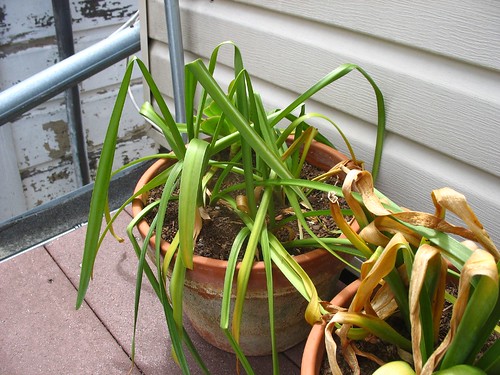
Vita Sackville-West says to divide Leucojum aestivum immediately after flowering.
"[A]estivum means summer. Leucojum vernum is more true to its adjective, since it really flowers in spring, even as early as February or March... Like the snowdrop [Galanthus], it should be dug up and divided and replanted as soon as the flower begins to fade. This seems rather a strange thing to do, when we are always told to let foliage of bulbs turn yellow and die down before attempting to lift the bulbs at all. Snowdrops and snowflakes work contrariwise. They like to be lifted while they are still in full green leaf, broken up, and reassembled in new young clumps."Now she tells me. Well, I'm a little late. The proper division and reassembly will have to wait until next year.
It became necessary to remove an Echium. It was leaning into the path and I had to push it out of the way every time I walked by. Doing that several times a day loosened the root crown rather badly and the whole thing was in steep decline.
Before:
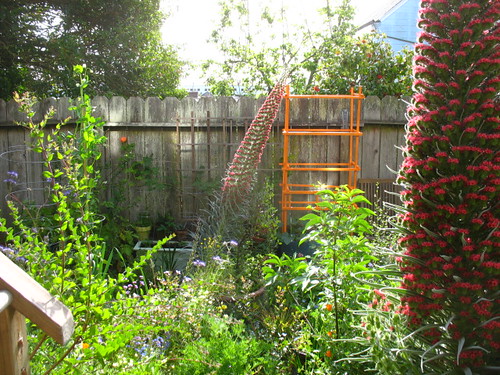
After:
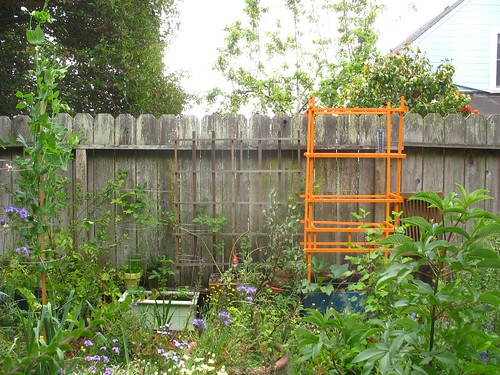
We still have the other Echium...

And it continues to be a bee and hummingbird magnet.
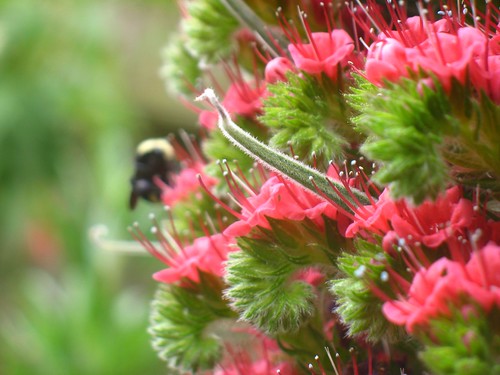
This freed up space for me to plant Aloe ferox. I'm not sure how far down the road I will go with Aloe ferox. I want to incorporate more succulent species in the garden (right now most all my succulents are potted plants), but this is going to take so long to grow. We'll see if I can stick it out before another idea demands to be manifested.
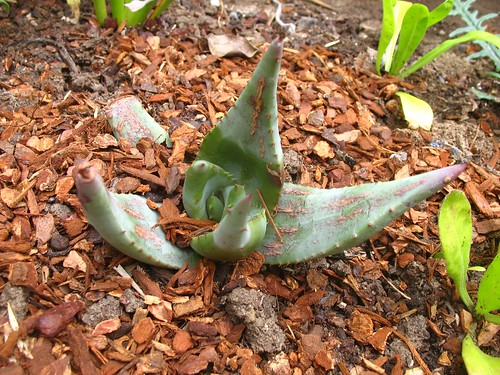
The spring wildflowers have been So. Much. Fun. At this point I'm wondering why anyone--esp. in California--would grow any annuals at all besides the native wildflowers. Then again, I'm not sure that people do grow annuals much anymore, do they? Annuals are rather out of fashion. It's all about perennials and flowering shrubs for most people. What a shame.
I love the Cream Cups, Platystemon californicus. Color-wise, it's a cool gray and its texture is coarse. For best effect, interplant masses or clumps with something green and fine, like Gilia tricolor or Nemophila menziesii.
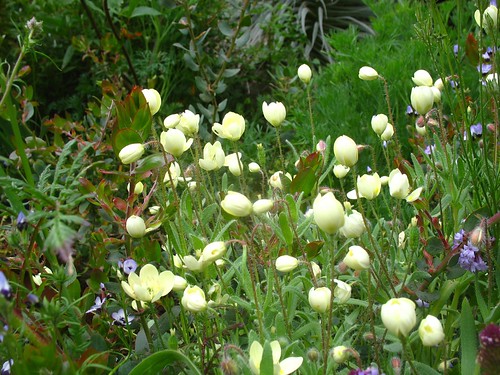
Gilia tricolor goes with everything. Here it is intergrading with the new spring growth of manzanita. Intricate and fragrant little flowers massed at the ends of trailing stems invite close attention.
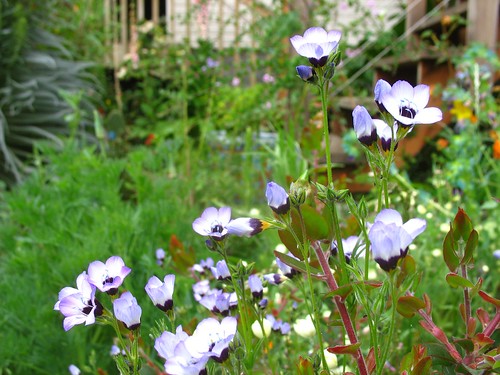
The most vigorous seedlings of Phacelia tanacetifolia turned in to huge plants. Having just a few of these in a small garden like mine is plenty. In comparison, the less vigorous specimens seem weak and unappealing. Next year, just keep the big ones.

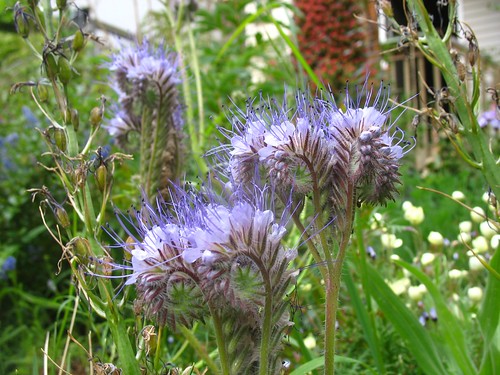
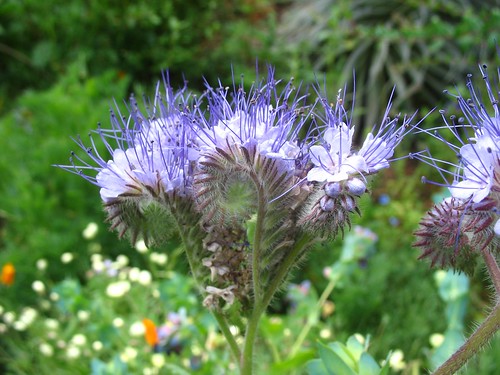
Phacelia campanularia was a revelation to me. I've seen it before in other people's gardens, but having it in mine was a solid thrill. I suggest growing it apart from other wildflowers which dilute the impact of its cool, cobalt blue flowers (although, I'd like to see it near 'Moonlight', the creamy white form of the California poppy).
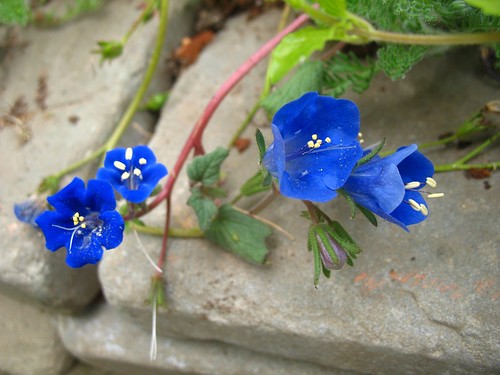

Note how the foliage turns a rosy pink.

Layia platyglossa could barely withstand the slugs in my garden this winter. The best specimens all grew in containers, not the ground. Fortunately, my garden has lots of containers and that's where I'll direct all my efforts with this plant next year.
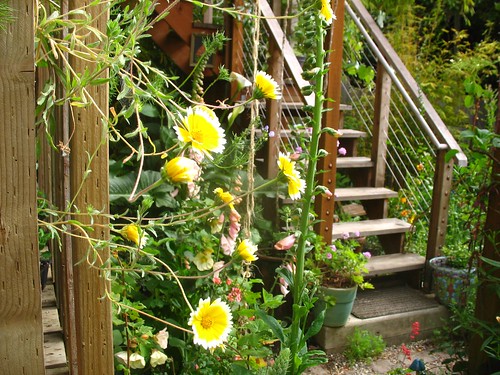
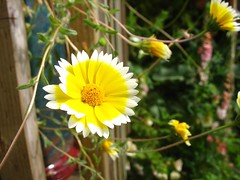
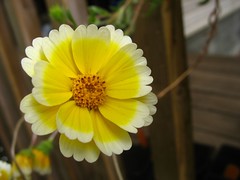
Nemophila maculata is one I may grow less of next time. It's fine on its own, but seems too busy to combine with anything else. I let it grow in amongst the carrots and onions where it fills space and covers ground. In places where its flowers opened alongside other wildflowers, I detected no visual synergy from any particular combination.

Unless the blooms blow me away in the next few weeks, Collinsia heterophylla (Chinese Houses) is another one I'll plan to do with less of next year. Shade-tolerant according to garden books, but it etiolated and lodged in my garden's shade--not to mention succumbing massively to slugs.
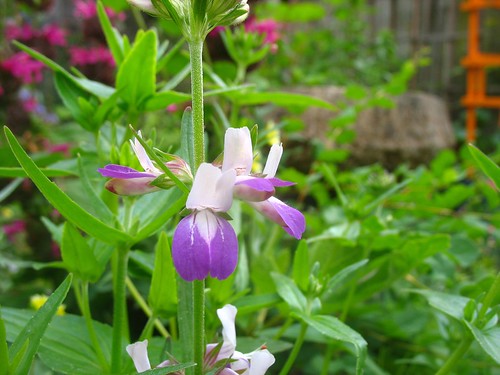
Phacelia grandiflora--nice, but I already have so much purple in my garden and this isn't adding anything.

Gilia achilleifolia. It seems to be mostly plant with just a tiny bit of flower. That ratio makes it a non-starter for the small city wildflower garden.

Recent raccoon raids left me doubting the continued existence sugar snap pea seeds I sowed recently. I couldn't abide sowing them again so I, gulp, bought snap pea plants. I yanked the bamboo teepee and put my new curly iron posts where it was so the snap peas can twine up the posts. And I stuck this Bay Area native sunflower from Annie's Annuals right in the middle.
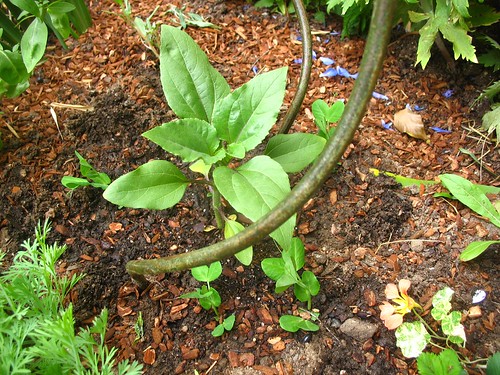
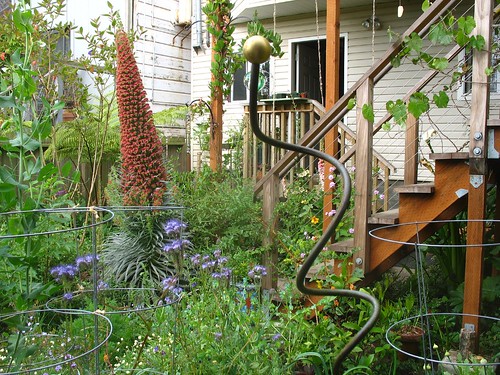
The potatoes vines have ripened. I've stopped watering and the vines are dying back. Soon I'll harvest the potatoes and sow cucumber seeds.
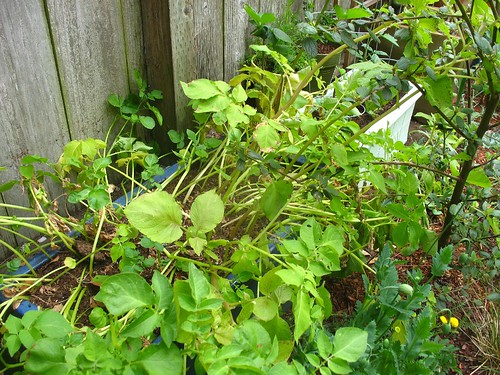
Piggy will appreciate that.
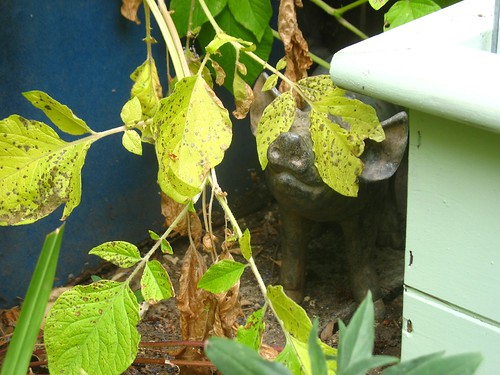
Raintree Nursery has special on bareroot vine maples (Acer circinatum) right now--buy five or more for $9.50 each. Emma and I went in together and bought a bunch. I tucked a few in here and there between the foxglove in anticipation of foxglove not being around for very much longer.
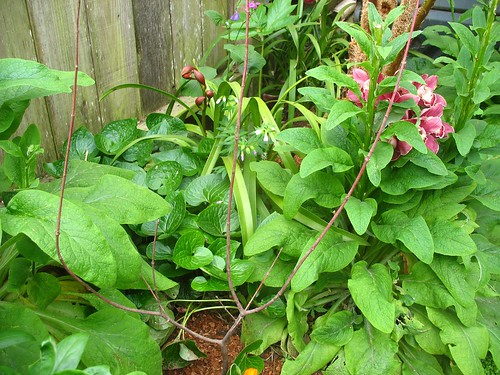
Next to the Meyer lemon, I yanked out the Silver Bush Lupine (Lupinus albifrons) because it was crowding the lemon. Yes, well, everything crowds everything in my garden, but priorities must be established. I replaced the lupine with Psoralea pinnata (Fabaceae), a South African tree/shrub with flowers that smell like grape juice.
I can't find a before shot, but this is what it looks like now.
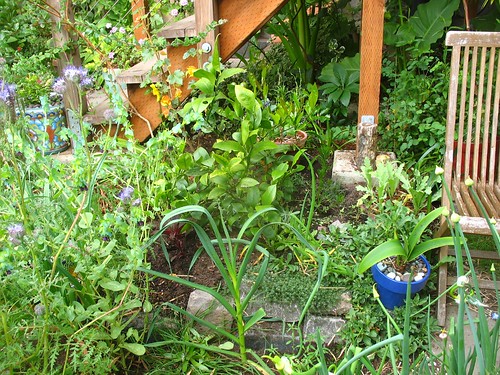
Behind the lemon I yanked out a woody, overgrown Cerinthe major and replaced it with a new one that I bought from Annie's Annuals. All the cerinthe in my garden are volunteers from last year. I thought I should bring in some fresh genetic material to keep the population from getting inbred. I want it to keep coming back.
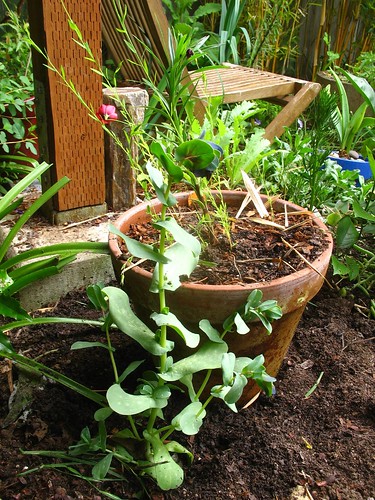
I have to make a decision about the giant Zantedeschia aethiopica 'Hercules'. It's just a big, chaotic mess. I love the giant flowers--and this cultivar is the giant of the species; it will get much bigger still. But realistically it may have to go.
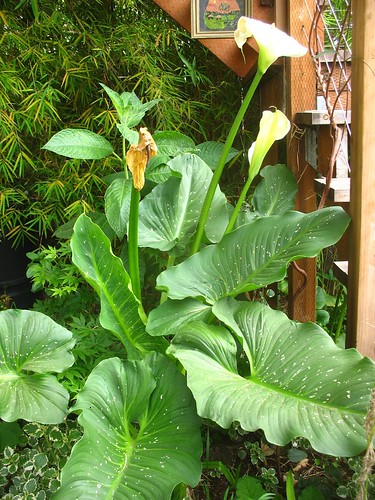
It appears that I've acquired a reputation via this blog for having a Seussical garden. This new vertical space-saving strategy for my herb garden slash strawberry patch will do nothing to discourage that assessment.

Guy's not sure what to think of it ("too fanciful", he said), but Penny approves.
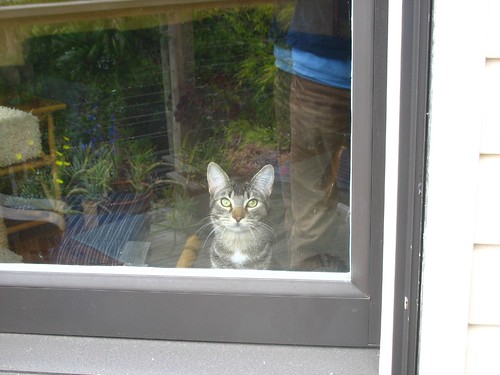

13 comments:
I really enjoy visiting your garden. Always so many beautiful things to see. Shame about the Echium. But very pretty annuals (so many I had never seen before). You really should post more pictures of your kitty, he is adorable. And BTW I really like the strawberries pot.
I like that thermometer! All the pictures are great but now I am coveting Echium (too cold here) and Phacelia campanularia. Is it really that blue?
You've def. convinced e to grow more native annuals. If I ever get around to it.
It will probably take a few years for your Aloe ferox to grow up into this. I'm glad you're trying it though: I covet one, but I don't have room for it.
So much to digest, thank goodness for the soothing sight of Penny at the door. The blue flowers and pink leaves of the phacelia is a genius combination worthy of the good doctor himself. That is the purest blue ever. I am astonished that you could buy sugar snaps seedlings, they will be a work of art on your metal twist. Our sugar snaps finally have flowers, they are so tall that they fell over the fence, I didn't know they would get five feet high. Better get the dip recipe out, we eat them raw as a dipper.
Here the native annuals are free to roam where ever they wish. Some times they disappear and new seed needs to be flung about.
My sugar snap peas have been duds so far. I planted a second round of seeds a few days ago.
Sugar snap peas have been a mixed bag for me so far this year. (Last year, they were a constant success all year long.) I think it was too cold to grow them in the ground until just about now. Containerized snap peas have done better for me so far this year. Unfortunately, I have to say they are not very tasty this year, either. :(
Alex, what a stunning Ale ferox. I didn't realize they grew vertically. You can buy them in 2" pots for very little money. Then you can sit on it for a few years while you decide if you "have room" for it or not. That's sort of what I'm doing.
Layanee--it really is that blue. Bluer, even. (The red foliage comes late, with lots of sun and heat.)
Thank you for coming by Gintonio--I always think you and I have the most similar gardens of the garden blogs that I tend to visit most frequently--even if there are some differences in plant material.
I'm so excited that you are putting an Aloe ferox in the ground! I have to get one - maybe I'll get a little one, too - we can have an Aloe race!
I totally agree with you about the nemophila - it goes with nothing. I really want it to work in gardens ... but I'm too much of a plant matcher-upper. It's off my list.
How much do I love your garden? THIS MUCH!!!!
Oh my god. So all this time when you were showing the echium photos, I was thinking it was about the size of a rather large foxglove. Not! The scale of that beauty is amazing... I'm falling in love all over again!
I love the Suessical pot solution. I can't wait to try that with more strawberry plants.
I'm new to gardening and love the site. My paperwight flowers are all spent but I wasn't sure what to do with the plant since it is still green. Do I need to dig the bulbs up or just leave them in the pot and move them?
I'm in the Excelsior and loving my new garden. Slugs, snails and all.
Most people throw out last year's bulbs, but if you want to keep them for next year, this is what I do:
Keep the leaves in sun for awhile so the plant can photosynthesize and store energy in the bulb.
Once the leaves start to die back, you can move the pot to a less visible location (e.g., in the garage). Once the leaves have mostly died, lift the bulbs, cut off what's left of the leaves, and store the bulbs in a paperbag somewhere cool and dry until November-ish, when it's time to plant them out again. Break off any large-ish bulbs budding out from the main bulb--those are free plants for next year.
You could try leaving the bulbs in the same pot all summer long, but I think the bulb roots will want to find fresh, nutrient-rich soil when they start to grow again, not the exhausted stuff from last year. So you might as well lift them.
Several highly-esteemed garden bloggers report success lifting and transplanting bulbs any time after the flower is done, although you will never read that advice in a gardening book.
When the flowers on the bulbs I want to keep are done for the season, I will often dunk the whole pot in a large bucket of very dilute Miracle Gro and let it soak thoroughly (no more air bubbles) and then put it out in sun without any more watering. I figure it's one last blast of nutrients and water before going to sleep for the summer.
Some people say to cut the dead flower heads off so the bulb doesn't waste energy making seeds, and other people say that's hogwash. Use your judgment.
Thanks for the advise on the bulbs. I had already cut the flowers off, mostly because they looked bad. Maybe that is why the plant looks so good still. I would really like to plant them again next year, they were really beautiful and did well.
I've been reading your blog and some of the links you've had. As a new gardener most of the books I've read have assumed at least some experience. Thanks for the inspiration.
I like your problem of limited space, it really helps you make the tough decisions that maximize the wow factor. It's a great tutorial for me, cuz' I have too much space and easily wind up with "duh" combos. I like the stacked pots, though I can see Guys' point, too. (But what's wrong with fanciful? :) Penny sure is growing up...do either of them try to get outside? I want to get harness/leash combo's for the boys to come outdoors, but my son said he tried it once and the cats were just limp and sulking. We'll see.
Wowsers! The plants in your garden are spectacular. I am drooling over the echiums in particular. I just bought one at our local garden center (in Colorado) and am now thinking there is no way that will grow here!
Post a Comment